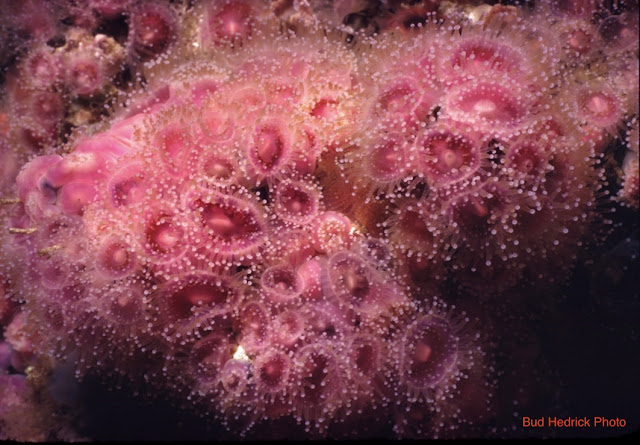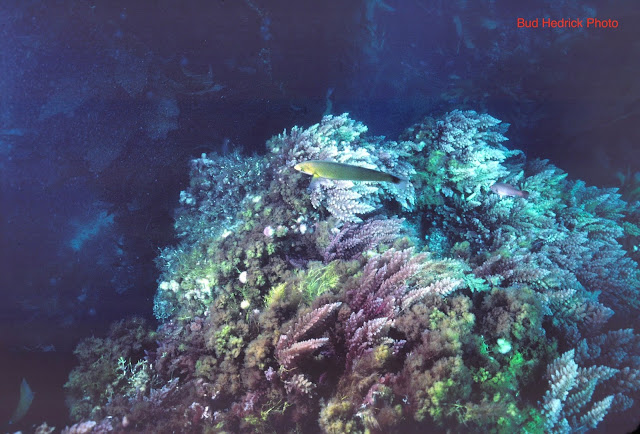My hope is to treat you to a glimpse of the extent of color and beauty displayed by the Sea Anemones and some of the other living creatures that I have seen during my ventures under water. Since I lack a formal education in the subject of Marine Biology you won’t be burdened with Latin or classifications. Most anemones can’t swim, they attach themselves to the bottom with a foot-like pad and orient themselves to face the current. They can, when needed, move rather awkwardly across the sea floor, twisting and pushing with the foot. They are said to be carnivorous, but probably omnivorous is more correct because they can also be seen eating plant life at times. It is reported that there are more than 1000 sea anemone species found throughout the world's oceans at various depths, although the largest and most varied occur in coastal tropical waters. They run the full spectrum of colors and can be as small as half an inch or as large as over three feet across. Some sea anemones are armed with stinging cells and can be poisonous to humans.

Not all polyps sting or have stingers but the little Clownfish seems able to share a symbiotic relationship with a number that do and finds shelter from adversaries while cleaning the polyp growth and eating the residuals.
Stalks of Anemone Polyps.
Anemones grow in a variety of configurations, some in stalks, some like buttercups and others in tube shapes.
Buttercups
This is the Tube Anemone. Standing firmly here it appears to be growing out of the sea floor, but as mentioned it can move when needed to take advantage of the ever changing currents or as a defense. Next to it lies a slow moving sea worm known as a Sea Cucumber. Called Bêche-de-mer in Australia, where it is harvested for the oriental market, it is also known as Trepang in China and Indonesia where it is used as an ingredient in soups and stews.
The Anemones Mouth
Another small fish, also unconcerned about being stung, seeks shelter from the diver among the polyps.
Anemones often retract while digesting or sleeping at night. Here are two sharing the same locale, one is still fishing while the other digests and snoozes.
The collar, or top edge of the bucket is easily visible -

As the tentacles of the anemones are of divergent colors so are the body cavities different, some being striped while others are spotted.
It is not uncommon to see anemones that have chosen to reside on top of a coral formation instead of the sea floor.
I had never seen one like it so I was surprised while diving one afternoon to swim by this big anemone. It looked fierce so I approached slowly and took pictures without getting too close. It was the largest anemone that I had seen, about three feet across and I had no idea that they grew to such a size. Appearing to be attached between two coral heads it showed no sign of movement except for the polyps which waved to and fro in the current. Over the next few days I returned several times to take more photos and noticed each time that it had changed shape but hadn't moved from the spot. At each occasion it was apparent that there was a different shape to the collar on the bucket and that the polyp tentacles were exposed in a different manner. Some times open wide and other times half or totally closed.
This is the same anemone pod as the previous photo however, taken at a different angle, day and time, so the light is quite different. But it allows us to see how the creature changes shape.
Here are some views of the tropical soft corals.
Equally beautiful as the anemones but different creatures.
The whites are hard coral and the red is the soft.
Looking closely you can see soft and hard corals and an anemone in the photo.
We end this post with four examples of the plant life that lives under the California kelp. Lets call them, underwater florals.
That's all for this post
But if you haven't looked at the "KelpLady" site please find time to do so.
And for more reading I have two books available at Amazon Books.

Link to: Spain and the Bulls
Cruise of the Gringo Vagabundos

Link to: Cruise of the Gringo Vagabundos





























Fantastic colors and creatures. Can't wait for the next installment.
ReplyDeleteIncredible shots Bud, masterfully done. What are you shooting with?
ReplyDelete